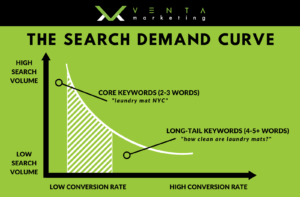Keywords are at the heart of any paid media, content marketing, or SEO campaign. Keywords are the chainlinks that connect consumers and businesses. However, not all keywords are created equal. Core keywords and long-tailed keywords serve two different roles within a marketing strategy.
The targeting of core keywords or long-tailed keywords largely depends upon your campaign goals and timeline. As the building blocks for any type of advertising, it all starts with keyword research. Let’s be clear, keyword research isn’t hard to do. Almost anyone can do it with a little guidance on what they are looking for. But GOOD keyword research is difficult to come by.
Someone truly needs to know what they are doing when highlighting keywords and phrases to use. This research discovers what the most common terms users are searching for inside their internet queries. Here’s where expert keyword research is necessary… Just because a search term has a lot of queries attached to it, doesn’t make it a good choice to target.
Real, thoughtful strategy goes into identifying keywords — both core and long-tail. Factors like competition, price value, customer relevance, conversion trends, sales funnel position, and more, all play a role in the evaluation of a keyword.
Before we dig into the direct differences between core and long-tailed keywords, an important distinction to make is where your campaign ads are attempting to catch consumers?

Awareness Stage: Purely informational, seeking to promote the purpose or use of a product or service.
Consideration Stage: Works to influence the user who is considering the use of a product or service. With persuasive messaging, aims to motivate the user by highlighting the benefits and positive takeaways.
Decision Stage: Attempts to create a transaction with the user. Looks to solidify the product or service advantage to buying.
Core vs. Long-Tails
Now to get down to the nitty-gritty.
Core keywords are the anchors to your marketing plan. These words often encapsulate what your company directly sells or provides, and may include your geographic location. For example, “laundry mat NYC” might be one core keyword for a laundry mat located in New York City.
Core keywords typically follow these trends:
- 2-3 Words
- High Search Volume
- High Ranking Competition
- Higher Cost
- More Broad in Definition
- Lower Conversion Rate
The primary purpose of core keywords is to provide an introduction to the product or service for a consumer looking to gather information. Core keywords focus on the top of the sales funnel, looking to start nurturing consumers into potential leads.
On the opposite end, long-tail keywords are used to attract consumers further along in the buying process. These keywords are hyper-focused on specific topics and ideas, attempting to give further in-depth information to influence their buying probability.
Long-tail keywords typically follow these trends:
- 4+ Words
- Low Search Volume
- Low Competition
- Low Ranking Competition
- Very Specific in Definition
- Higher Conversion Rate
A visual representation of this relationship between core and long-tailed keywords can be seen in a demand curve.

While not all keywords are created equal, both are essential to the selling process. Whether SEO campaigns or paid media ads, the use of highly-vetted keywords is critical to your marketing success.
Need Keyword Help?
At Venta Marketing, we are helping businesses meet their goals head-on. As leaders in the digital marketing industry, we know the ins-and-outs of what good keyword research looks like. Contact us today if you are curious about our services!
